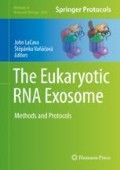Abstract
RNA exosome complexes degrade many different RNA substrates. Substrate selection and targeting to the exosome complex rely on cofactors, which bind to the substrate RNA, recruit the exosome complex, and help to remodel the associated ribonucleoprotein particle to facilitate RNA degradation. These cofactors are RNA-binding proteins, but their interaction with RNA may be very transient because the RNAs they are bound to are rapidly turned over by the exosome complex. Hence, the cofactors involved in the degradation of many exosome substrates are unknown. Here, we describe comparative poly(A)+ RNA interactome capture as a method to screen for novel RNA-binding proteins involved in exosome-dependent RNA decay.
For this, we compare the poly(A)+ RNA interactome of wild-type cells to that of RNA surveillance mutants, where the decay of exosome substrates is compromised and occupancy of exosome cofactors on RNA is strongly increased. More specifically, protein–RNA complexes in wild-type and mutant cells are UV–cross-linked in vivo after labeling with the photoactivatable nucleoside analogue 4-thiouracil. Following cell lysis, protein–RNA complexes are selected on oligo d(T) beads, subjected to stringent washes, and eluted in a low salt buffer. After RNase digestion of cross-linked RNA, RNA-binding proteins that are enriched in the mutant samples are identified by quantitative mass spectrometry. Here, we quantitatively compare the RNA–protein interactomes of wild-type and rrp6Δ cells to selectively determine cofactors of the nuclear RNA exosome complex in fission yeast. With minor modifications, the comparative interactome approach can easily be adapted to study a range of different RNA-dependent processes in various cellular systems.
Access this chapter
Tax calculation will be finalised at checkout
Purchases are for personal use only
Change history
01 December 2020
A correction has been published.
References
Kilchert C, Wittmann S, Vasiljeva L (2016) The regulation and functions of the nuclear RNA exosome complex. Nat Rev Mol Cell Biol 17(4):227–239
Zinder JC, Lima CD (2017) Targeting RNA for processing or destruction by the eukaryotic RNA exosome and its cofactors. Genes Dev 31(2):88–100
Mistry DS, Chen Y, Sen GL (2012) Progenitor function in self-renewing human epidermis is maintained by the exosome. Cell Stem Cell 11(1):127–135
McIver SC et al (2016) Exosome complex orchestrates developmental signaling to balance proliferation and differentiation during erythropoiesis. Elife 5. https://doi.org/10.7554/eLife.17877
McIver SC et al (2014) The exosome complex establishes a barricade to erythroid maturation. Blood 124(14):2285–2297
Harigaya Y et al (2006) Selective elimination of messenger RNA prevents an incidence of untimely meiosis. Nature 442(7098):45–50
Kilchert C et al (2015) Regulation of mRNA levels by decay-promoting introns that recruit the exosome specificity factor Mmi1. Cell Rep 13(11):1–12
Lee NN et al (2013) Mtr4-like protein coordinates nuclear RNA processing for heterochromatin assembly and for telomere maintenance. Cell 155(5):1061–1074
Egan ED, Braun CR, Gygi SP, Moazed D (2014) Post-transcriptional regulation of meiotic genes by a nuclear RNA silencing complex. RNA 20(6):867–881
Zhou Y et al (2015) The fission yeast MTREC complex targets CUTs and unspliced pre-mRNAs to the nuclear exosome. Nat Commun 6:7050
Shah S, Wittmann S, Kilchert C, Vasiljeva L (2014) lncRNA recruits RNAi and the exosome to dynamically regulate pho1 expression in response to phosphate levels in fission yeast. Genes Dev 28(3):231–244
Yamashita A et al (2012) Hexanucleotide motifs mediate recruitment of the RNA elimination machinery to silent meiotic genes. Open Biol 2(3):120014
Castello A et al (2012) Insights into RNA biology from an atlas of mammalian mRNA-binding proteins. Cell 149(6):1393–1406
Castello A et al (2013) System-wide identification of RNA-binding proteins by interactome capture. Nat Protoc 8(3):491–500
Beckmann BM et al (2015) The RNA-binding proteomes from yeast to man harbour conserved enigmRBPs. Nat Commun 6:10127
Baltz AG et al (2012) The mRNA-bound proteome and its global occupancy profile on protein-coding transcripts. Mol Cell 46(5):674–690
Sysoev VO et al (2016) Global changes of the RNA-bound proteome during the maternal-to-zygotic transition in Drosophila. Nat Commun 7:12128
Tyanova S, Temu T, Cox J (2016) The MaxQuant computational platform for mass spectrometry-based shotgun proteomics. Nat Protoc 11(12):2301–2319
Tyanova S et al (2016) The Perseus computational platform for comprehensive analysis of (prote)omics data. Nat Methods 13(9):731–740
Rogell B et al (2017) Specific RNP capture with antisense LNA/DNA mixmers. RNA 23(8):1290–1302
Dölken L et al (2008) High-resolution gene expression profiling for simultaneous kinetic parameter analysis of RNA synthesis and decay. RNA 14(9):1959–1972
van Nues R et al (2017) Kinetic CRAC uncovers a role for Nab3 in determining gene expression profiles during stress. Nat Commun 8(1):12
Acknowledgments
This work was supported by a Wellcome Trust Senior Research fellowship to L.V. (WT106994MA) and a Medical Research Council career development award to A.C. (MR/L019434/1).
Author information
Authors and Affiliations
Corresponding author
Editor information
Editors and Affiliations
Rights and permissions
Copyright information
© 2020 Springer Science+Business Media, LLC, part of Springer Nature
About this protocol
Cite this protocol
Kilchert, C., Hester, S., Castello, A., Mohammed, S., Vasiljeva, L. (2020). Comparative Poly(A)+ RNA Interactome Capture of RNA Surveillance Mutants. In: LaCava, J., Vaňáčová, Š. (eds) The Eukaryotic RNA Exosome. Methods in Molecular Biology, vol 2062. Humana, New York, NY. https://doi.org/10.1007/978-1-4939-9822-7_13
Download citation
DOI: https://doi.org/10.1007/978-1-4939-9822-7_13
Published:
Publisher Name: Humana, New York, NY
Print ISBN: 978-1-4939-9821-0
Online ISBN: 978-1-4939-9822-7
eBook Packages: Springer Protocols

